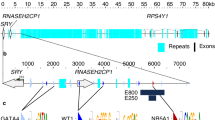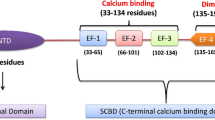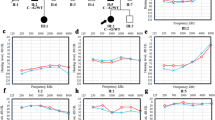Abstract
SRY gene is responsible for initiating male sexual differentiation. The protein encoded by SRY contains a homeobox (HMG) domain, which is a DNA-binding domain. Mutations of the SRY gene are reported to be associated with XY pure gonadal dysgenesis. The majority of these are de novo mutations affecting only one individual in a family. Only a small subset of mutations is shared between the father and one or more of his children. Most of these familial mutations are localized within the HMG box and only two are at the N-terminal domain of the SRY protein. Herein, we describe a young girl with pure gonadal dysgenesis and her father carrying a novel familial mutation in the SRY gene at codon number 3. This mutation is resulting in a serine (S) to leucine (L) substitution. The secondary structure of the SRY protein was carried out by protein modelling studies. This analysis suggests, with high possibility, that the N-terminal domain of the SRY protein, where we found the mutation, could form an α-helix from amino acid in position 2 to amino acid in position 13. The secondary structure prediction and the chemical properties of serine to leucine substitution stands for a potential disruption of this N-terminal α-helix in the SRY protein. This mutation could have some role in impeding the normal function of the SRY protein.
Similar content being viewed by others
Log in or create a free account to read this content
Gain free access to this article, as well as selected content from this journal and more on nature.com
or
References
Sinclair AH, Berta P, Palmer MS et al: A gene from the human sex-determining region encodes a protein with homology to a conserved DNA-binding motif. Nature 1990; 346: 240–244.
Koopman P, Gubbay J, Vivian N, Goodfellow P, Lovell-Badge R : Male development of chromosomally female mice transgenic for Sry. Nature 1991; 351: 117–121.
Wilson M, Koopman P : Matching SOX: partner proteins and co-factors of the SOX family of transcriptional regulators. Curr Opin Genet Dev 2002; 12: 441–446.
Wegner M : From head to toes: the multiple facets of Sox proteins. Nucleic Acids Res 1999; 27: 1409–1420.
Kamachi Y, Uchikawa M, Kondoh H : Pairing SOX off: with partners in the regulation of embryonic development. Trends Genet 2000; 16: 182–187.
Stenson PD, Ball EV, Mort M et al: Human Gene Mutation Database (HGMD): 2003 update. Hum Mutat 2003; 21: 577–581.
Shahid M, Dhillon VS, Aslam M, Husain SA : Three new novel point mutations localized within and downstream of high-mobility group-box region in SRY gene in three Indian females with Turner syndrome. J Clin Endocrinol Metab 2005; 90: 2429–2435.
Knower KC, Kelly S, Harley VR : Turning on the male – SRY, SOX9 and sex determination in mammals. Cytogenet Genome Res 2003; 101: 185–198.
Jordan BK, Jain M, Natarajan S, Frasier SD, Vilain E : Familial mutation in the testis-determining gene SRY shared by an XY female and her normal father. J Clin Endocrinol Metab 2002; 87: 3428–3432.
Schmitt-Ney M, Thiele H, Kaltwasser P, Bardoni B, Cisternino M, Scherer G : Two novel SRY missense mutations reducing DNA binding identified in XY females and their mosaic fathers. Am J Hum Genet 1995; 56: 862–869.
Affara NA, Chalmers IJ, Ferguson-Smith MA : Analysis of the SRY gene in 22 sex-reversed XY females identifies four new point mutations in the conserved DNA binding domain. Hum Mol Genet 1993; 2: 785–789.
Domenice S, Yumie Nishi M, Correia Billerbeck AE et al: A novel missense mutation (S18N) in the 5′ non-HMG box region of the SRY gene in a patient with partial gonadal dysgenesis and his normal male relatives. Hum Genet 1998; 102: 213–215.
Radi O, Parma P, Imbeaud S et al: XX sex reversal, palmoplantar keratoderma, and predisposition to squamous cell carcinoma: genetic analysis in one family. Am J Med Genet 2005; 138: 241–246.
Porollo AA, Adamczak R, Meller J : POLYVIEW: a flexible visualization tool for structural and functional annotations of proteins. Bioinformatics 2004; 20: 2460–2462.
Kabsch W, Sander C : Dictionary of protein secondary structure: pattern recognition of hydrogen-bonded and geometrical features. Biopolymers 1983; 22: 2577–2637.
Werner MH, Huth JR, Gronenborn AM, Clore GM : Molecular basis of human 46X,Y sex reversal revealed from the three-dimensional solution structure of the human SRY-DNA complex. Cell 1995; 81: 705–714.
Shahid M, Dhillion VS, Jain N et al: Two new novel point mutations localized upstream and downstream of the HMG box region of the SRY gene in three Indian 46,XY females with sex reversal and gonadal tumour formation. Mol Hum Reprod 2004; 10: 521–526.
Cameron FJ, Sinclair AH : Mutations in SRY and SOX9: testis-determining gene. Hum Mutat 1997; 9: 388–395.
Schafer AJ : Sex determination and its pathology in man. Adv Genet 1995; 33: 275–329.
Harley VR, Clarkson MJ, Argentaro A : The molecular action and regulation of the testis-determining factors, SRY (sex-determining region on the Y chromosome) and SOX9 [SRY-related high-mobility group (HMG) box 9]. Endocr Rev 2003; 24: 466–487.
Brown S, Yu C, Lanzano P et al: A de novo mutation (Gln2Stop) at the 5′ end of the SRY gene leads to sex reversal with partial ovarian function. Am J Hum Genet 1998; 62: 189–192.
Author information
Authors and Affiliations
Corresponding author
Rights and permissions
About this article
Cite this article
Gimelli, G., Gimelli, S., Dimasi, N. et al. Identification and molecular modelling of a novel familial mutation in the SRY gene implicated in the pure gonadal dysgenesis. Eur J Hum Genet 15, 76–80 (2007). https://doi.org/10.1038/sj.ejhg.5201719
Received:
Revised:
Accepted:
Published:
Issue date:
DOI: https://doi.org/10.1038/sj.ejhg.5201719
Keywords
This article is cited by
-
SRY protein function in sex determination: thinking outside the box
Chromosome Research (2012)
-
Swyer’s Syndrome: In a Fifty-Year-Old Female
The Journal of Obstetrics and Gynecology of India (2012)
-
A SRY-HMG box frame shift mutation inherited from a mosaic father with a mild form of testicular dysgenesis syndrome in Turner syndrome patient
BMC Medical Genetics (2010)



